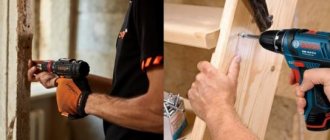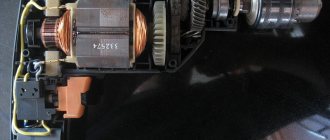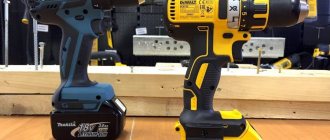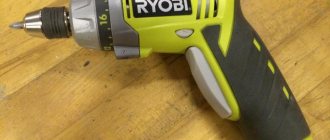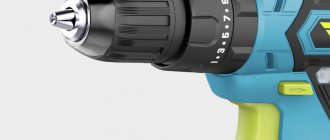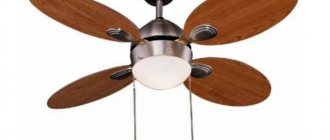Selecting a screwdriver
by voltage and other parameters
When choosing a screwdriver suitable for certain tasks, you should pay special attention to different properties. Among them, not only the power of the device and the capacity of its battery are important, but also the battery voltage, and sometimes the torque
.
When carrying out construction and repair work, a screwdriver is an indispensable tool that simplifies the tightening of various types of fasteners, and sometimes even drilling holes. And, despite the fact that there are two versions of this device - mains and battery-powered, more often the latter option is chosen to perform household tasks. At the same time, attention is paid to the parameters of the power tool itself and to such characteristics as the voltage in the screwdriver, its power, torque and battery capacity . Each of these indicators is important for evaluating and choosing the correct device. Whereas it’s not worth buying based on suitable power or voltage alone.
How to choose a screwdriver?
A screwdriver is now one of the most popular tools, a must-have not only for professional builders, but also for any home craftsman. The huge number of models that are now on sale make choosing a good screwdriver quite difficult. What should you pay attention to first when purchasing? Let's look at all the main selection criteria in order.
Additional options
also influence the choice of a particular screwdriver . For example, the presence of several torque setting modes, which allows you to adjust the tightening force of the screw.
A useful option is the motor brake, thanks to which the screwdriver instantly stops immediately after you release the power button.
Modern professional screwdrivers have a battery charge indicator. Using this function, you can easily control the operating time of this battery.
Some Metabo screwdriver models have an additional pulse operating mode. It allows you to easily unscrew tightly tightened screws, as well as drill bits and hard materials.
Also now there are screwdrivers with brushless motors. This technology allows you to significantly increase the service life of the screwdriver .
If you need to use a screwdriver to drill, for example, concrete, then you should pay attention to screwdrivers with an impact function.
FAQ: how to choose a screwdriver
Headlight polishing kit
Price: US $8.96 / 651.93 rub.
During the operation of the car, even the highest quality headlights begin to transmit light worse, which is due to clouding of the coating and loss of transparency. This problem can be easily solved using this simple kit with masking tape, double-sided fine-abrasive sandpaper and a special polishing liquid.
What are the advantages of choosing cordless screwdrivers?
Cordless screwdrivers can be used in any working environment. Cordless electric screwdrivers are convenient and can be used indoors without a power source. They are limited by autonomy and battery power.
Cordless screwdrivers are especially good for furniture assembly because they allow you to move around different parts with ease. They are also widely used for fastening drywall and for dismantling or assembling car body parts. On the other hand, the battery charge must be sufficient to guarantee the torque necessary for screwing. It is recommended to provide at least one spare battery to avoid problems associated with battery drain.
For portable screwdrivers, it is important to keep in mind the weight of the device with battery, which can be about 2 kg for high-power screwdrivers.
As a rule, cordless screwdrivers are equipped with lithium-ion batteries. These batteries offer the best performance today: they are lighter than other types of batteries and have better charging capacity. The higher the intensity of the battery, the higher its autonomy. Screwdriver batteries generally come in three types: batteries less than 1.5 Ah (amp-hour), batteries 1.5 to 2 Ah, and batteries greater than 2 Ah.
Battery characteristics for cordless screwdrivers:
- their power is expressed in volt-amperes (VA). The more powerful the battery, the more autonomy the screwdriver and the higher the torque.
- their voltage affects the torque: the higher the voltage, the higher the torque will be.
- their intensity affects autonomy: the higher the intensity, the longer the battery life will be.
Makita
Makita spare parts can also be purchased separately. The manufacturer offers a universal charger for all existing types of batteries. The system will automatically select the required voltage.
On a special control panel you can see the progress of the process. If the battery is not working, this will also be indicated.
Prices for Makita spare parts start at 2,000 rubles (for household models). Chargers and batteries for professional tools will cost much more.
How to choose an electric screwdriver?
The choice of electric screwdriver depends on how you intend to use it. For example, will you use it frequently in construction? For construction or renovation? In a machine shop? For furniture? for assembly?
The second point that needs to be determined is the frequency of use of the screwdriver. If it will be used all day, it is better to use a model with a wire. However, if it will only be used for 2-3 hours a day, a rechargeable model is ideal, perhaps with an additional battery and charger nearby. Do not forget to carefully study the ergonomics of the screwdriver , especially if it will be used intensively.
Torque is another important criterion to consider. Increased torque corresponds to high screwing force. The higher the torque, the easier it is to screw, even in hard materials.
READ Which Screwdrivers Are Best To Use For Ice Drills
Does battery capacity affect power? Metabo PowerMaxx BS test / TEST
Torque is directly related to the power of the screwdriver . For corded screwdrivers with mains power, the power directly depends on the motor power. It ranges from 450 to 705 watts (watt). If the screwdriver is powered by an external transformer, the higher the supply voltage, the higher the power of the screwdriver. The power of cordless screwdrivers depends on the battery voltage. It can vary from 3.6 V to 18 V (volts) for the most powerful screwdrivers. In the case of cordless screwdrivers, high voltage ensures longer battery life and eliminates the need to charge batteries too often. Some screwdrivers are called impact screwdrivers: they are used for intensive screwing/unscrewing.
Rotation speed is a key feature, especially if you need to use a screwdriver regularly: corded screwdrivers tend to have a higher rotation speed than cordless screwdrivers. As a rule, screwdrivers have one single rotation speed. For corded screwdrivers it ranges from 3000 to 6000 rpm, and for cordless screwdrivers it ranges from 180 to 450 rpm. For impact drivers, the speed is specified in blows per minute: it ranges from 3,000 to 50,000 blows per minute.
- screw configuration
- frequency of use
- torque
- energy source
- rotational speed
How to choose the right electric screwdriver
An electric screwdriver is a portable electrical device that allows you to screw and unscrew easily. The screwdriver head is equipped with a holder, which can be magnetic or have a quick release system. The holder allows you to quickly install the attachment to match the impression on the screw head.
This manual only applies to screwdrivers, portable power tools that only have screwing and unscrewing functions. They should not be confused with Drill Drivers.
Which screwdriver model should I choose?
You have a choice between thermal types of screwdrivers:
- Straight screwdrivers, the body of which corresponds to the screwing axis. These screwdrivers are well suited for jobsites where they can be suspended from a drum system with a top-down screwdriving direction. Some straight screwdrivers are designed for CNC operation on automated workstations.
- Pistol-shaped screwdrivers with curved bodies for better grip.
- Angle screwdrivers that allow you to reach screws located in hard-to-reach places.
- straight screwdrivers
- pistol shaped screwdrivers
- angle screwdrivers
Typical manufacturing errors
Typical errors in the manufacture of power supplies come down to incorrect connection of elements. If you install carefully, these problems can be avoided. You also need to remember that the screwdriver is weight-balanced for working with a battery. If you remove the battery completely, it will be very inconvenient to work. Therefore, it is necessary to leave the inoperative battery by removing the contact plates.
From the video you will learn what you can make from an old screwdriver charger.
Another option is to remove the spent elements from the battery case, securing a corresponding load inside instead. The rest of the manufacturing of the power supply should not cause any problems, and the old tool will get a new life.
What are the advantages of choosing a screwdriver with manual?
The corded screwdriver is designed for intensive use. It is characterized by high torque. Its second advantage is its low weight due to the absence of a battery. You can choose a corded model if the power source is located close to where you will use the screwdriver .
The corded screwdriver is suitable for use in industrial assembly stations, mechanical workshops, i.e. in confined areas. Its advantage lies in intensive use. However, the wire connecting it to the power supply may present a restriction due to its length (restricting access to all parts for screwing or unscrewing) or even a risk of failure if routed through a passage.
Portable corded electric screwdrivers are usually designed to operate on single-phase power. Assembly station screwdrivers typically require 32 or 40 volts DC power from the control unit.
Charge voltage and form factor
There is no international standardization for the voltage of autonomous power supplies for power tools.
You should understand! Increasing this parameter allows you to reduce the weight and size of the battery. Lithium blocks are assembled from standard cells (1.2V).
For this reason, the resulting voltage will be as follows (for the number of batteries):
- 10 pcs. – 12V;
- 11 – 13,2;
- 12 – 14,4;
- 13 – 16,6;
- 14 – 17,8.
Which type of screwdriver should I choose: corded or cordless?
There are 2 large groups of electric screwdrivers: corded models, which usually have more power, and cordless models that run on a battery.
An important parameter that must be taken into account is the weight of the screwdriver . With the same power, corded screwdrivers are lighter than cordless screwdrivers. Their weight directly depends on the weight of the battery.
- screwdrivers with manual
- cordless screwdrivers
Gaming keyboard
Price: from US $14.40 / 1047.75 rub.
This retro-style wired gaming keyboard has a Russian layout, a backlight that shimmers with all the colors of the rainbow, a soft stroke of spectacular round keys and a durable plastic case. And the ergonomics here, in general, are at their best. In addition, the keyboard is waterproof and it is possible to order delivery from a warehouse in Russia.
What options are available?
Some screwdrivers are equipped with a torque control system. They can turn off after reaching a predetermined torque, either after the screw is fully tightened, or after the screw has jammed, thereby avoiding transmission of torque to the operator. This system can be mechanical or electronic.
The most modern screwdrivers include electronic settings for connection to external systems, allowing for very precise settings. The cheapest screwdrivers provide only mechanical adjustment of torque and speed. Some inexpensive screwdrivers have no adjustments at all.
There are also screwdrivers that are equipped with an LED, allowing the user to properly position the bit on the screw head in poorly lit work areas.
- force couple regulation
- lighting
What does the voltage of a screwdriver affect?
How to choose a drill/screwdriver
This tool is in great demand both in the professional sphere and among home craftsmen. In everyday life, when people say “screwdriver” they usually mean “drill-screwdriver”, but in reality these are different tools.
The screwdriver is intended for use with fasteners only. As a rule, this tool is equipped with a chuck with a depth limiter (for working with drywall) or a quick-release chuck with spring fixation for bits.
The power tool has a built-in mechanism that stops the rotation of the chuck at the moment when the resistance of this rotation reaches its maximum. Also, many screwdrivers operate when you press on the screw; you no longer need to press the trigger button. This greatly simplifies the work with fasteners and saves time. Screwdrivers are lighter and more mobile than drills and screwdrivers, and if there is no need for the drilling function, you should choose a screwdriver. This tool is in great demand among those who work with drywall.
As you may have guessed, you can also drill holes using a drill/driver. Next, we will consider this tool in more detail.
Brush motors have stood the test of time. But, despite all their advantages, they also have a number of disadvantages. The brushes wear out quite quickly; during operation, sparks often occur at the point where the brushes come into contact with the armature, and a lot of heat is generated. Energy consumption is much higher than brushless ones.
Brushless motors do not have the disadvantages of the opponent. They have smaller dimensions with the same power, emit less heat, do not “spark” during operation, and do not have wear parts. You can read more about brushless motors in a separate article.
If you have the choice between a brushed and brushless motor, you should definitely choose brushless.
Torque determines the area of application of the tool. A drill/driver is a fairly versatile tool that can both tighten a screw and drill a hole.
A wide range of special attachments allows you to expand the tool area even further. With their help, you can transform a drill-driver even into metal nibblers.
Of course, clever craftsmen are expanding the scope of application even further.
Let's get back to torque. Measured in Nm (newtonmeters) The greater the torque, the greater the force the tool can overcome, and therefore the more powerful it is. The torque is determined by the power of the tool, which depends on the engine and battery. The documentation for the device usually indicates the maximum possible diameter and length of the screw. In household screwdrivers, the average torque ranges from 10 to 30 N/m. This is enough to cope with most necessary tasks. A professional screwdriver can have a torque of 100 N/m or more.
READ How much to charge a 12 Volt Screwdriver Battery
How to choose a screwdriver, what characteristics should you pay attention to when purchasing?
The relationship between torque and screw diameter.
A very important characteristic of a good drill/ driver is the ability to adjust the torque. The adjustment clutch allows you to set the desired torque, thereby choosing the force with which the tool will work. If you do NOT calculate the force of the tool, you can break the attachments and damage the heads of the screws. Therefore, an adjustment clutch equipped with 20 or more adjustment steps is intended for such purposes. The higher the degree, the more force the tool exerts during operation.
The rotation speed indicates the number of revolutions of the working nozzle per unit of time. It should be noted that for ordinary work with screws and self-tapping screws, a speed of 450-550 rpm or even less is sufficient. If a drill-driver is used for drilling, then this requires a speed of 1000 rpm.
These are relatively small rotation speeds, since, for example, in an angle grinder the rotation speed can reach 11,000 rpm.
Often. The rotation speed of the drill and screwdriver is regulated by the force of pressing the “trigger” button. But some tools have 2 or 3-speed gears, which are switched using a special toggle switch.
The drill/driver can be equipped with a single-clutch keyless chuck or a double-clutch chuck.
In the case of a two-socket chuck, in order to install the equipment, you need to clamp it and tighten it. In this case, you have to rotate the ring with one hand and hold the cartridge with the other. Which is not entirely convenient.
Nowadays, most power tools come with a single-socket keyless chuck. To clamp the drill, you do not need to hold the chuck. This convenience is provided by spindle locking. When the spindle is in working condition, the lock is not active. But once the electric motor stops, the blocking is activated. It becomes impossible to turn the spindle manually. This makes replacing the drill much easier. Simply insert the accessory into the chuck and tighten it.
Despite the fact that this design of the chuck makes the drill/driver universal in use, at the same time the chuck can interfere with operation. Since the dimensions of the tool increase. To solve this problem, manufacturers equip models with a quick-release chuck. This allows you to quickly remove the chuck by retracting the ring at the rear and install the bits.
When a person chooses a screwdriver for use at home, he does not always pay attention to these parameters. Of course, if you use a screwdriver a couple of times a month, they are NOT critical. But if the tool will be used almost every day for several hours, then criteria such as weight and ergonomics are extremely important.
The sharper the angle between the handle and the working part, the faster you will get calluses and the faster your hand will get tired during use. If this is not critical for short-term use, then for long-term use it is a very significant problem.
Such a seemingly trifle can lead to such unpleasant consequences.
The heavier the tool, the easier it will be to drive screws into hard surfaces. But the hand gets tired much faster. A small tool is more convenient for use in hard-to-reach places; the hand does not get tired as quickly, but at the same time we lose power. Makita also makes specialized tools for working in hard-to-reach places, such as angle drills and screwdrivers.
Drills and screwdrivers can be powered from an electrical outlet or from a battery.
It is advisable to use a corded screwdriver if the work is carried out in a permanent work area with access to the network. However, cordless screwdrivers are more in demand due to their charging benefits. They are mobile, the power cord does NOT get tangled underfoot, and it is not necessary to have a power supply at the place of work.
Let's take a closer look at what types of batteries there are and how they differ.
Battery capacity, voltage and type
Nickel-cadmium (NiCd) is an outdated type of battery that large manufacturers are abandoning in favor of better ones.
Nickel-metal hydride (Ni-MH) batteries, also an obsolete type with minor advantages over NiCd, are also becoming a thing of the past.
Lithium-ion batteries (Li. Ion) are a new type of battery that is actively used in modern cordless tools. This is the best type of battery available today. The price is justified by the long service life. Also, thanks to interchangeability, you can save money. For example, buy a drill/driver with a battery included and an angle grinder without a battery and use them in turn.
The higher the battery voltage, the higher the maximum torque of the tool. The minimum voltage is 9.6V; such batteries are used in screwdrivers or cordless screwdrivers. Next come batteries 10.8 V, 12 V, 14.4 V, 18 V and 24 V. 24 V batteries are already quite serious batteries and are already used in cordless angle grinders or rotary hammers. The maximum voltage is 36V, but such batteries are rarely used since above 36V already constitute a danger to humans and a higher risk of explosion.
Battery capacity is measured in ampere hours (Ah) and the operating time of the tool depends on it. The minimum capacity is from 1.5 Ah to 3 Ah. Of course, it is difficult to say exactly how long the tool will work on one charge. A lot of factors affect the operating time, including the load on the tool, ambient temperature and much more. Definitely, the larger the capacity, the longer the operating time on a single charge, but with the capacity, the weight also increases. Most drills/drivers operate for 3-4 hours on a single charge at an average load, and charge in less than an hour (many Makita drills/drivers charge in 22 minutes using a modern DC18RC charger). If you choose a battery with a large capacity, you will need to work with heavy weight during working hours. Therefore, it is more advisable to charge a battery with a lower capacity during a break. Of course, if you want to pump up without going to the gym, choosing a battery with a large capacity will undoubtedly be justified.
The impact mode allows you to increase the torque several times, which significantly expands the capabilities of the tool both when drilling and when tightening screws.
This cartridge has a special fixation that prevents the possibility of unwinding during operation. This option is very useful when working with the tool at high torques.
Quite often we are faced with the fact that we need to tighten a screw or drill a hole in a place where the room lighting does not reach. Working with a flashlight at the ready is, to put it mildly, inconvenient. This backlight greatly simplifies such tasks.
This feature is very useful for any battery-powered device. Thanks to it, you will avoid a situation where the tool runs out of charge at the most inopportune moment during work. Knowing the battery charge level makes it much easier to plan work.
An extremely necessary thing for a powerful drill- driver You get additional emphasis when drilling hard surfaces, without which drilling is extremely difficult and inconvenient.
The drill/screwdriver set usually includes a carrying case. The manufacturer Makita has more complete configurations. For example, the Makita BDF458RFJ cordless drill-driver also includes 2 BL 1830 batteries, a charger, a keyless chuck, and an attachment. side handle and Makpac transport case. By purchasing a tool with two batteries included, you can increase the time of continuous operation by alternating batteries. Also, thanks to the interchangeability of lithium-ion batteries in the Makita B tool, you can save money by purchasing a tool without a battery included. For example, angle grinder DGA452Z.
READ Which Battery Is Better For A Screwdriver
A drill and screwdriver is a very popular tool in both the professional and domestic spheres. Remember, when choosing, the main criterion is the type of work and tasks that you set for the tool. When constantly working with plasterboard structures, it is enough to purchase a screwdriver, which is much lighter and more mobile. When working with harder materials and larger screw diameters, it is better to choose a drill/driver, which can be used to pre-drill a hole for the screw if necessary.
The versatility of the tool is a definite plus, but if you constantly need to hammer nails, it’s not worth buying an ax.
Powering the device from a laptop battery
A screwdriver connected to an outlet is only suitable for a DIYer. However, a lithium-ion battery from a laptop can be inserted into the tool body. The first step is to disassemble the case. Then the old battery is removed and the wiring is disassembled. The new power source is connected to the instrument. Polarity is very important to consider here. It is necessary to make a special hole on the case and bring the plug into it. This is necessary so that the battery can be charged from the mains.
Screwdriver, how to choose
One of the most common tools among craftsmen is a screwdriver. In terms of popularity, it is perhaps located right behind the drill, although it includes some of its functions. The main purpose of this tool is to screw in screws, or rather, to screw in self-tapping screws.
Let's look at the basic requirements that need to be taken into account when choosing a screwdriver. They are divided into two main types, namely network ones, operating from a 220 volt household network, and rechargeable ones, respectively, operating from a battery. Since networked ones are not very common, we will NOT consider them specifically, but will only say that many selection parameters automatically become relevant for networked screwdrivers.
How many volts should a screwdriver be? The battery voltage of a screwdriver directly affects its power. From the school physics course we know that power is equal to the product of voltage and current. It follows from this that the higher the operating voltage of the battery, the higher the power of the device. Of the screwdrivers on the market, the most common battery voltages are 6, 12, 18, 24 and 36 volts. this voltage is always indicated by the manufacturer on the product label.
How many watts should a screwdriver be? This issue was partially covered in the previous paragraphs. But let’s summarize, the more powerful the screwdriver, the more comfortable it is to work with it. It is worth considering that the power of the device must match the battery. The battery power must be designed for the energy consumption of the motor, which is built into the screwdriver. If the ratios are incorrect, you can get your battery drained quickly. It should also be noted that the more powerful the device and the more powerful the power source, the higher the weight and dimensions of the tool. Well, as a result - a higher price for a screwdriver. If we consider the battery power, then most likely it is more correct to say not the power, but the battery capacity. It is measured in ampere hours and designated as Ah.
Screwdriver, which battery to choose? Three types of maintenance-free batteries are common in household appliances and tools: nickel-cadmium (Ni-Cd). nickel-metal hydride (Ni-MH) and lithium-ion (Li-Ion). The first and second have a huge drawback - memory. Over time, these types of batteries begin to charge and NOT fully discharge. This leads to a loss of power from the element, or simply put, to the loss of our precious ampere-hours. In addition, the average number of charge-discharge cycles is 1000 cycles. If you use the tool intensively, the batteries will quickly fail. There are various ways to resuscitate such containers, but this is quite problematic, and they are NOT restored completely and not for a long time. Lithium batteries have no memory effect, but they do not withstand extreme temperatures well. But such batteries are more durable and much lighter than their counterparts. The price to pay for owning a lithium-ion battery is the higher cost of the screwdriver.
What should be the torque in a screwdriver? Some clarification is needed here. This refers to the tightening torque of the screwdriver, or rather the torque. For car enthusiasts, the expression “torque” is probably familiar. In order not to overwhelm you with definitions, I’ll simply say that the tightening torque is the maximum constant load on the Screwdriver at which the device can continue screwing at a constant speed. The higher the torque, the longer and thicker the screws you can “drive” into walls and other obstacles. Torque is measured in Newtons per meter and is abbreviated as Nm. It is advisable NOT to buy screwdrivers with a torque below 10-12 Nm.
Screwdriver, what rotation speed should I choose? Here you must determine for yourself. If you want to use the device only for tightening screws, then this is one thing, but if there is a desire or need to also drill something inadvertently, then this device should have completely different characteristics. When talking about characteristics, we will mean the rotation speed of the rotor. For standard screwdrivers it is about 750 rpm. There are also two-speed models, which may be more expensive, but here you already get two speed ranges. For example 750 and 1200 rpm. Is second speed so important for a screwdriver? It’s hard to say, because the work will be done in both cases. With small volumes of screw driving, you will NOT feel this at all, but the screwdriver as a drill has already completely flashed on the horizon. But here again, the speed of a full-featured drill averages 2400 rpm. If your Screwdriver is capable of this, then good. The opposite situation is when they want to get a screwdriver from a drill. This will not exactly be an equal exchange, since the drill has a friction clutch. A friction clutch is a device that is adjusted to operate at a certain torque value. If you tighten small screws, then set the triggering moment less. Otherwise, at a high moment, the screwdriver will drive the screw so deeply that this may become a prerequisite for the rejection of the wall, board and other parts into which this screw was screwed. In a drill, the default clutch is comments.
Is it worth taking a screwdriver with a hammer drill function? A hammer drill is a function of a drill and it serves to drill into resistant surfaces such as concrete, brick, etc. If you want your Screwdriver to work like a good drill, then feel free to purchase a model with such bells and whistles. Otherwise, this is a redundant function and it’s not worth overpaying for it. Be sure to read the article Why concrete won't drill? Drills burn and break.
Screwdriver, whose to choose? More precisely, the question posed sounds like which manufacturer of screwdriver to choose. In this situation, the choice is up to you. We discussed all of the above selection factors. You just have to proceed from the parameters of convenience, price and personal sympathy. We will not list famous brands and tell you about their advantages and disadvantages. You work with the tool. Look. Is it comfortable to hold in your hand, will it be heavy when performing long-term work, etc. We are sure you will get what you need!
Sources:
https://guide.directindustry.com/ru/kak-pravilno-vybrat-shurupovert-elektricheskii/ https://makitools.com.ua/index.php?route=blog/articlearticle_id=3 https://domolov.ru /shurupovyort-kak-vybrat.html
Mock Tests
Before starting to build a working structure, you should test everything on the knees, make sure that the screwdriver is operating stable under load and that there is no severe overheating in the power supply.
We take the computer power supply and check it: plug it into the network, find green in the output bundle of wires (they say it can be a different color, but I always came across green ones) and connect it with a jumper to any of the black ones (all black wires at the output are the common output, in our case it is a minus). The unit should turn on and a voltage of 12 volts will appear between the black and yellow wires. You can check this with a multimeter or by connecting any computer cooler to the named terminals.
If everything is in order and the unit produces about 12 volts on the yellow (+) and black (-) terminals, continue. If there is no voltage at the output, we look for another unit or repair this one; this separate topic will be described separately.
We cut off the plug from the output of the block and take 3-4 yellow and black wires coming from the block and connect them in parallel. When cutting off the plug, do not forget about the green starting conductor, it must be shorted to black. We received a 12 V source with a decent current load capacity of 10-20 A, the currents depend on the model and power of the unit.
Now we need to connect our 12 V to the terminals of the screwdriver without a battery; we look at the polarity of the connection using the battery. Well, we check the screwdriver - at idle speed, then slowing down by hand. At this stage, I encountered a problem: when I press the button fully, the screwdriver works, but when I slowly, smoothly press the screwdriver button, the power supply goes into protection. To reset the protection, you must disconnect the unit from the network and turn it on again. This won’t work at all, we need to somehow correct this instability.
I pulled the block board out of the case and additionally hooked up a multimeter to constantly monitor the voltage
In my opinion, this phenomenon may occur due to the fact that the power supply and the screwdriver button are controlled by PWM controllers; due to interference along the power wires, the controllers somehow interfere with each other. We are trying to solve this problem using an improvised LC filter.
I assembled the filter in 5 minutes from what was at hand: 3 electrolytic capacitors of 1000 uF at 16 volts, a non-polar capacitor of less than 1 uF and wound 20 turns of copper wire with a diameter of 2 mm on a ferrite ring from another unit. Here is his diagram:
And this is what he looks like. This is a purely trial version, in the future this design will be transferred to the battery housing of the screwdriver and will be made more accurately.
We check the entire structure: the block does not go into protection in any position of the button, great! Now you can try tightening several screws - all in a bunch. It seems that the screwdriver will be able to tighten larger screws.
Well, now you need to remove all the snot and piles of wires, remove the “dead cans” from the battery case, replace them with an LC filter, and test the screwdriver in more realistic conditions.
